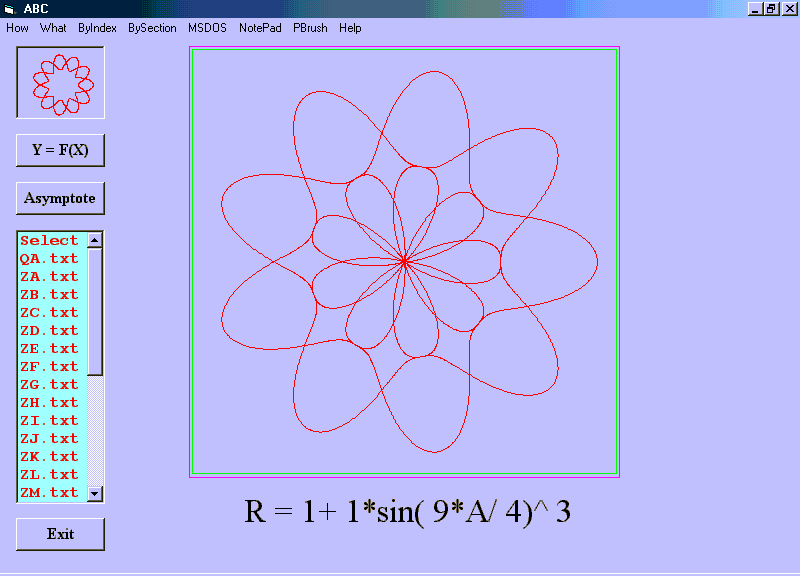Q1. Where can we get this diagram of R=1+1*sin(9*A/4)^3 ?
A1. It is in chapter 52 and program 6
Q2. How to get this diagram on internet ?
A2. It requires Program ABG
* Step 1 : Use
program ABG
to get the graph of R=1+1*sin(9*A/4)^3
* Step 2 : After enter program ABG
- Click Start to get menu.
- Click Topic 5 in upper box.
- The bottom diagrams contain the diagram of this function.
* Step 3 : Click Back to see more samples.
Q3. What is the cycle domain of r=1+1*sin(9*A/4)^3 ?
A3. The cycle domain is from 0 to 2*q*pi if p is odd M is odd
* Hence cycle domain is 8*pi since p=9, q=4 and M=3
* We can prove it graphically
- Step 1 : Use
program ABG
- Step 2 : After entering program ABG
- Click Start to get menu.
- Click subject 1 in upper box.
- Click program 06 in lower boox.
- Give values 9, 4, 3 for p, q, M.
- Left diagram is incomplet and A = 0 to 4*pi.
- right diagram is completA = 0 to 8*pi.
- Hence the cycle domain is 2*q*pi or 8*pi.
- Click Back command to see more samples.
* The maximum value of R=a+b*sin(p*A/q)^M is (a+b)
Q4. Study the following questions
A4. Questions
- Compare y=sin(x) and r=sin(A).
- Patterns of R=1+1*sin(p*A/4)^M.
- Convert r=sin(A) to (x-h)^2+(y-k)^2=r^2.
- Find petals of r=sin(3.1*A).
- Find pattern of r=0+1*sec(p*A/4)^M.
- Find pattern of r=0+1*sec(p*A/4)^M.
- Find pattern of r=1+1*sin(p*A/4)^M.
- Find pattern of r=2+4*sin(p*A/4)^M.
- Find pattern of r=4+2*sin(p*A/4)^M.
- Find pattern of r=4+2*tan(p*A/4)^M.
Study Tools
- Step 1 : Use
program ABG
- Step 2 : Select program after entering ABG
- Click start to enter the menu.
- Click subject to enter the program menu.
- Click program number.
- Enter oncstants if requred.
- Click Back command to continue.
Example : Prove that R=sin(N*A) has 2*N petals if N is even.
- It is in subject 2 for R = 0 + 1*sin(p*A/q)^M.
- That is a=0, p=interger, q=1 and M=1.
- The diagrams in top row is for p=1,2,3,4,5,6.
- For p=2,4,6 and petals = 4,8,12.
- Graphical proof is completed.
|



